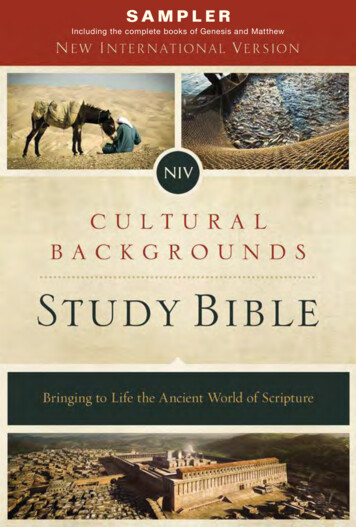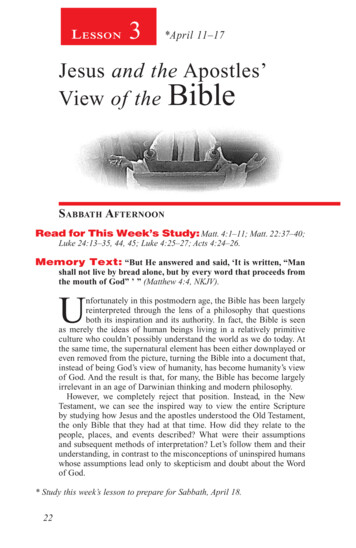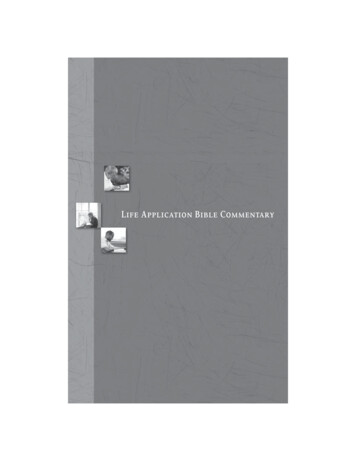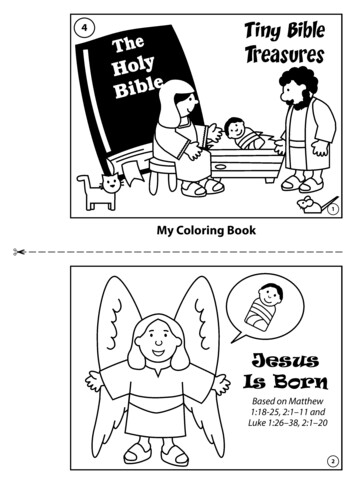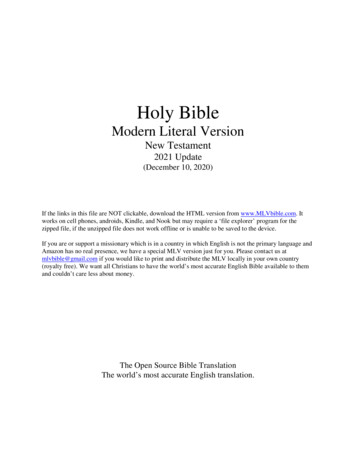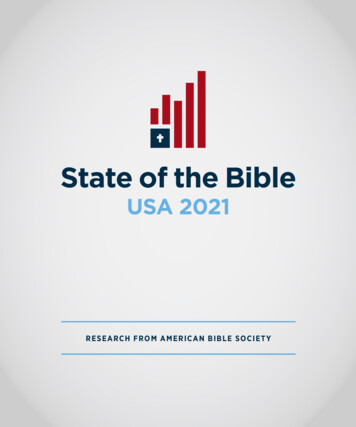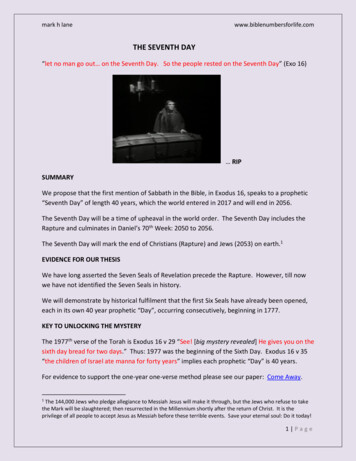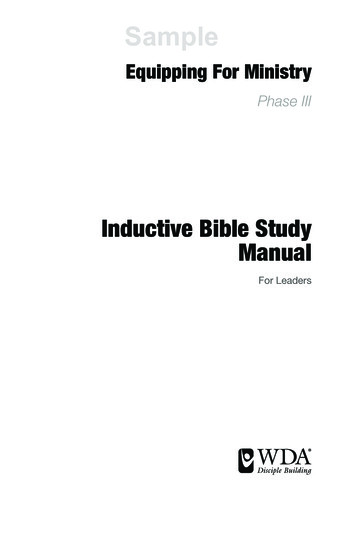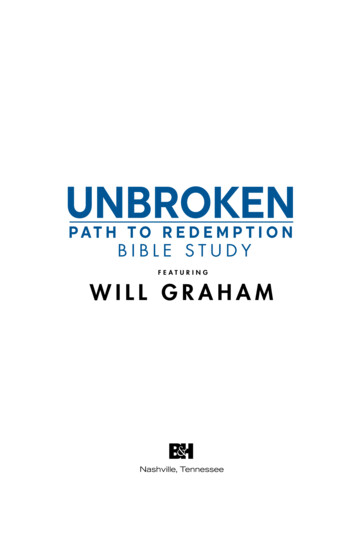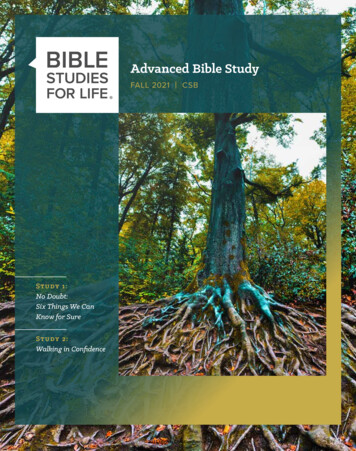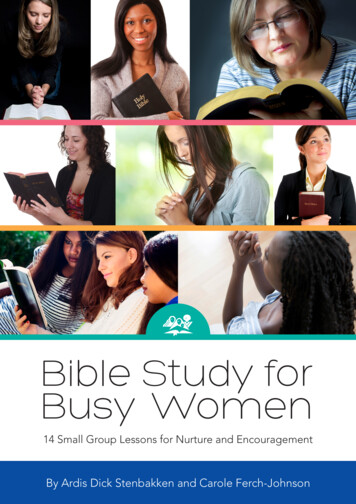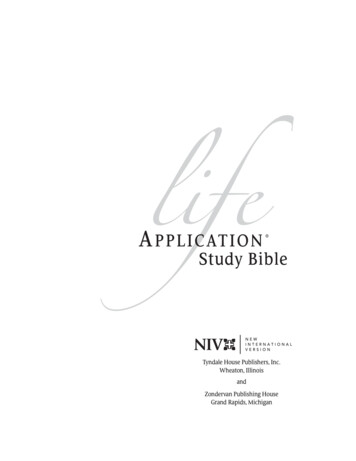
Transcription
lifeA P P L I C AT I O N Study BibleTyndale House Publishers, Inc.Wheaton, IllinoisandZondervan Publishing HouseGrand Rapids, Michigan
The Life Application Study Bible, New International Version edition, is published jointly by Tyndale HousePublishers, Inc., and Zondervan. Hardcover editions are published by Tyndale House, and bonded leatherand genuine leather editions are published by Zondervan.Tyndale House Publishers gratefully acknowledges the role of Youth for Christ/USA in preparing the LifeApplication Notes and Bible Helps.The Bible text used in this edition of the Life Application Study Bible is the Holy Bible, New InternationalVersion .Life Application Study Bible copyright 1988, 1989, 1990, 1991, 1993, 1996, 2004, 2005 by Tyndale HousePublishers, Inc., Wheaton, IL 60189. All rights reserved.Life Application is a registered trademark of Tyndale House Publishers, Inc.Notes and Bible Helps copyright 1988, 1989, 1990, 1991, 1993, 1996, 2004, 2005 by Tyndale HousePublishers, Inc. New Testament Notes and Bible Helps copyright 1986 owned by assignment by TyndaleHouse Publishers, Inc. Harmony of the Gospels copyright 1986 by James C. Galvin. Maps in textcopyright 1986, 1988, 2005 by Tyndale House Publishers, Inc. All rights reserved. Used by permissionof Tyndale House Publishers. Inc.Color maps copyright 2000 by Zondervan. All rights reserved.Color presentation pages copyright 2005 by Tyndale House Publishers, Inc. All rights reserved.Cross-reference system copyright 1991 by Zondervan. All rights reserved. Used by permission ofZondervan.The Holy Bible, New International Version. Copyright 1973, 1978, 1984 by International Bible Society.The “NIV” and “New International Version” trademarks are registered in the United States Patent andTrademark Office by International Bible Society. Use of either trademark requires the permission ofInternational Bible Society.The NIV text may be quoted in any form (written, visual, electronic or audio) up to and inclusive of fivehundred (500) verses without express written permission of the publisher, providing the verses quoted donot amount to a complete book of the Bible nor do the verses quoted account for 25 percent or more of thetotal text of the work in which they are quoted.Notice of copyright must appear on the title or copyright page of the work as follows:Scripture taken from the Holy Bible, New International Version . NIV . Copyright 1973, 1978, 1984 byInternational Bible Society. Used by permission of Zondervan. All rights reserved.When quotations from the NIV text are used in nonsalable media, such as church bulletins, orders ofservice, posters, transparencies or similar media, a complete copyright notice is not required, but the initials(NIV) must appear at the end of each quotation.Any commentary or other Biblical reference work produced for commercial sale that uses the NewInternational Version must obtain written permission for use of the NIV text.Permission requests for commercial use within the U.S. and Canada that exceed the above guidelines mustbe directed to, and approved in writing by, Zondervan.Permission requests for commercial use within the U.K., EEC, and EFTA countries that exceed the aboveguidelines must be directed to, and approved in writing by, Hodder & Stoughton, Ltd., 47 Bedford Square,London WC1B 3DP, England.Permission requests for non-commercial use that exceed the above guidelines must be directed to, andapproved in writing by, International Bible Society, 1820 Jet Stream Drive, Colorado Springs, CO 80921.Copublished by:Tyndale House Publishers, Inc. ZondervanWheaton, Illinois 60189, USAGrand Rapids, Michigan 49506, USALibrary of Congress Cataloging-in-Publication DataBible. English. New International. 1997.Life application study Bible : New International Version.p. cm.Includes indexes.ISBN 0-8423-4892-1 (hardcover : alk. paper). — ISBN 0-8423-4893-X(hardcover indexed : alk. paper).I. Tyndale House Publishers. II. Title.BS195.N37 1997220.5′20814—dc21ISBN 0-8423-4892-1 HardcoverISBN 0-8423-4893-X Hardcover IndexedISBN 1-4143-0713-6 Hardcover Anniversary EditionPrinted in the United States of America09220821072006190518171697-2367
C ONT ENT SvList of the Books of the BibleviiThe NIV Cross-Reference Systemand AbbreviationsixPrefacexiiiContributorsxivA Chronology ofBible Events andWorld EventsxvWhy theLife Application Study BibleIs UniquexviiWhat Is Application?xixFeatures of theLife Application Study Bible1THE OLD TESTAMENT542A Harmony of the Books of Kings and Chronicles1517The Time between the Old and New Testaments1521THE NEW TESTAMENT1791A Harmony of the Gospels1796The Parables of Jesus1797Jesus’ Miracles andComparison of theFour Gospels1798Messianic Propheciesand Fulfillments1842Maps of Paul’s Journeys2179A Christian Worker’s Resource2193365-Day Reading Plan2197Table of Weights and Measures2199Abbreviations in the Master Index2201Master Index2299Index to Charts2303Index to Maps2305Index to Personality Profiles2307Dictionary/Concordance
L IST OF T H EBOOK S OF T H E BIBL EThe New TestamentThe Old 380388444490546NUMBERSDEUTERONOMYJOSHUAJUDGESRUTH1 SAMUEL2 SAMUEL1 KINGS2 2971 CHRONICLES2 SIASTESSONG OF S1 CORINTHIANS2 1 THESSALONIANS2026203220442 THESSALONIANS1 TIMOTHY2 121172128JAMES1 PETER2 PETER1 JOHN2 JOHN2131213421383 JOHNJUDEREVELATION
T H E NIVC ROSS-REF ERENC ESYST EMThe New International Version has one of the most accurate and best-organized crossreference systems available. The system used in this Bible contains more than 23,500references.The cross-references link words or phrases in the NIV text with counterpart Biblicalreferences listed in a side column on every page. The raised letters containing these crossreferences are set in a light italic typeface to distinguish them from the NIV text note letters,which use a bold typeface.The lists of references are in Biblical order with one exception: If reference is made to averse within the same chapter, that verse (indicated by “ver”) is listed first.In the Old Testament, some references are marked with an asterisk (*), which means thatthe Old Testament verse or phrase is quoted in the New Testament (see, for example, Genesis 1:3). The corresponding information is provided in the New Testament by the NIV textnote (see 2 Corinthians 4:6).Following is a list of abbreviations used in the cross-references:ABBREVIATIONS FOR THE BOOKS OF THE BIBLEGenesis . . . . . . . . . . . . . . . . GeExodus. . . . . . . . . . . . . . . . . ExLeviticus . . . . . . . . . . . . . . LevNumbers . . . . . . . . . . . . . . NuDeuteronomy. . . . . . . . . . . DtJoshua. . . . . . . . . . . . . . . . . JosJudges. . . . . . . . . . . . . . . . . JdgRuth . . . . . . . . . . . . . . . . . . Ru1 Samuel. . . . . . . . . . . . . . 1Sa2 Samuel. . . . . . . . . . . . . . 2Sa1 Kings . . . . . . . . . . . . . . . 1Ki2 Kings . . . . . . . . . . . . . . . 2Ki1 Chronicles . . . . . . . . . . 1Ch2 Chronicles . . . . . . . . . . 2ChEzra . . . . . . . . . . . . . . . . . . EzrNehemiah . . . . . . . . . . . . . NeEsther . . . . . . . . . . . . . . . . . EstJob . . . . . . . . . . . . . . . . . . . JobPsalms . . . . . . . . . . . . . . . . . PsProverbs . . . . . . . . . . . . . . . PrEcclesiastes. . . . . . . . . . . . EccSong of Songs. . . . . . . . . . . SSviiIsaiah . . . . . . . . . . . . . . . . . IsaJeremiah. . . . . . . . . . . . . . . JerLamentations . . . . . . . . . . . LaEzekiel. . . . . . . . . . . . . . . . EzeDaniel . . . . . . . . . . . . . . . . . DaHosea . . . . . . . . . . . . . . . . HosJoel. . . . . . . . . . . . . . . . . . . JoelAmos . . . . . . . . . . . . . . . . . AmObadiah . . . . . . . . . . . . . . . ObJonah . . . . . . . . . . . . . . . . . JnhMicah . . . . . . . . . . . . . . . . MicNahum . . . . . . . . . . . . . . . . NaHabakkuk . . . . . . . . . . . . HabZephaniah . . . . . . . . . . . . ZepHaggai. . . . . . . . . . . . . . . . HagZechariah . . . . . . . . . . . . . ZecMalachi. . . . . . . . . . . . . . . MalMatthew. . . . . . . . . . . . . . . MtMark. . . . . . . . . . . . . . . . . . MkLuke. . . . . . . . . . . . . . . . . . . LkJohn . . . . . . . . . . . . . . . . . . . JnActs . . . . . . . . . . . . . . . . . . . AcRomans . . . . . . . . . . . . . . . Ro1 Corinthians . . . . . . . . . 1Co2 Corinthians . . . . . . . . . 2CoGalatians. . . . . . . . . . . . . . GalEphesians . . . . . . . . . . . . EphPhilippians . . . . . . . . . . . PhpColossians . . . . . . . . . . . . Col1 Thessalonians. . . . . . . 1Th2 Thessalonians. . . . . . . 2Th1 Timothy . . . . . . . . . . . . 1Ti2 Timothy . . . . . . . . . . . . 2TiTitus. . . . . . . . . . . . . . . . . . TitPhilemon . . . . . . . . . . . . PhmHebrews . . . . . . . . . . . . . HebJames . . . . . . . . . . . . . . . . . Jas1 Peter . . . . . . . . . . . . . . . 1Pe2 Peter . . . . . . . . . . . . . . . 2Pe1 John . . . . . . . . . . . . . . . . 1Jn2 John . . . . . . . . . . . . . . . . 2Jn3 John . . . . . . . . . . . . . . . . 3JnJude . . . . . . . . . . . . . . . . . JudeRevelation . . . . . . . . . . . . Rev
P REF A C ETHE NEW INTERNATIONAL VERSION is a completely new translation of the Holy Biblemade by over a hundred scholars working directly from the best available Hebrew, Aramaicand Greek texts. It had its beginning in 1965 when, after several years of exploratory studyby committees from the Christian Reformed Church and the National Association of Evangelicals, a group of scholars met at Palos Heights, Illinois, and concurred in the need for anew translation of the Bible in contemporary English. This group, though not made up ofofficial church representatives, was transdenominational. Its conclusion was endorsed by alarge number of leaders from many denominations who met in Chicago in 1966.Responsibility for the new version was delegated by the Palos Heights group to a self-governing body of fifteen, the Committee on Bible Translation, composed for the most part ofBiblical scholars from colleges, universities, and seminaries. In l967 the New York Bible Society (now the International Bible Society) generously undertook the financial sponsorshipof the project—a sponsorship that made it possible to enlist the help of many distinguishedscholars. The fact that participants from the United States, Great Britain, Canada, Australia,and New Zealand worked together gave the project its international scope. That they werefrom many denominations—including Anglican, Assemblies of God, Baptist, Brethren,Christian Reformed, Church of Christ, Evangelical Free, Lutheran, Mennonite, Methodist,Nazarene, Presbyterian, Wesleyan, and other churches—helped to safeguard the translation from sectarian bias.How it was made helps to give the New International Version its distinctiveness. The translation of each book was assigned to a team of scholars. Next, one of the Intermediate Editorial Committees revised the initial translation, with constant reference to the Hebrew,Aramaic, or Greek. Their work then went to one of the General Editorial Committees, whichchecked it in detail and made another thorough revision. This revision in turn was carefullyreviewed by the Committee on Bible Translation, which made further changes and then released the final version for publication. In this way the entire Bible underwent three revisions, during each of which the translation was examined for its faithfulness to the originallanguages and for its English style.All this involved many thousands of hours of research and discussion regarding themeaning of the texts and the precise way of putting them into English. It may well be that noother translation has been made by a more thorough process of review and revision fromcommittee to committee than this one.From the beginning of the project, the Committee on Bible Translation held to certain goalsfor the New International Version: that it would be an accurate translation and one thatwould have clarity and literary quality and so prove suitable for public and private reading,teaching, preaching, memorizing, and liturgical use. The Committee also sought to preservesome measure of continuity with the long tradition of translating the Scriptures into English.In working toward these goals, the translators were united in their commitment to theauthority and infallibility of the Bible as God’s Word in written form. They believe that itcontains the divine answer to the deepest needs of humanity, that it sheds unique light onour path in a dark world, and that it sets forth the way to our eternal well-being.The first concern of the translators has been the accuracy of the translation and its fidelityto the thought of the Biblical writers. They have weighed the significance of the lexical andgrammatical details of the Hebrew, Aramaic and Greek texts. At the same time, they havestriven for more than a word-for-word translation. Because thought patterns and syntaxix
differ from language to language, faithful communication of the meaning of the writers ofthe Bible demands frequent modifications in sentence structure and constant regard for thecontextual meanings of words.A sensitive feeling for style does not always accompany scholarship. Accordingly theCommittee on Bible Translation submitted the developing version to a number of stylisticconsultants. Two of them read every book of both Old and New Testaments twice—once before and once after the last major revision—and made invaluable suggestions. Samples ofthe translation were tested for clarity and ease of reading by various kinds of people—youngand old, highly educated and less well educated, ministers and laymen.Concern for clear and natural English—that the New International Version should be idiomatic but not idiosyncratic, contemporary but not dated—motivated the translators andconsultants. At the same time, they tried to reflect the differing styles of the Biblical writers.In view of the international use of English, the translators sought to avoid obvious Americanisms on the one hand and obvious Anglicisms on the other. A British edition reflects thecomparatively few differences of significant idiom and of spelling.As for the traditional pronouns “thou,” “thee,” and “thine” in reference to the Deity, thetranslators judged that to use these archaisms (along with the old verb forms such as“doest,” “wouldest,” and “hadst”) would violate accuracy in translation. Neither Hebrew, Aramaic nor Greek uses special pronouns for the persons of the Godhead. A present-daytranslation is not enhanced by forms that in the time of the King James Version were used ineveryday speech, whether referring to God or man.For the Old Testament the standard Hebrew text, the Masoretic Text as published in the latest editions of Biblia Hebraica, was used throughout. The Dead Sea Scrolls contain materialbearing on an earlier stage of the Hebrew text. They were consulted, as were the SamaritanPentateuch and the ancient scribal traditions relating to textual changes. Sometimes a variant Hebrew reading in the margin of the Masoretic Text was followed instead of the text itself. Such instances, being variants within the Masoretic tradition, are not specified byfootnotes. In rare cases, words in the consonantal text were divided differently from theway they appear in the Masoretic Text. Footnotes indicate this. The translators also consulted the more important early versions—the Septuagint; Aquila, Symmachus andTheodotion: the Vulgate; the Syriac Peshitta; the Targums; and for the Psalms the JuxtaHebraica of Jerome. Readings from these versions were occasionally followed where theMasoretic Text seemed doubtful and where accepted principles of textual criticismshowed that one or more of these textual witnesses appeared to provide the correct reading. Such instances are footnoted. Sometimes vowel letters and vowel signs did not, in thejudgment of the translators, represent the correct vowels for the original consonantal text.Accordingly some words were read with a different set of vowels. These instances are usually not indicated by footnotes.The Greek text used in translating the New Testament was an eclectic one. No other pieceof ancient literature has such an abundance of manuscript witnesses as does the New Testament. Where existing manuscripts differ, the translators made their choice of readingsaccording to accepted principles of New Testament textual criticism. Footnotes call attention to places where there was uncertainty about what the original text was. The best current printed texts of the Greek New Testament were used.There is a sense in which the work of translation is never wholly finished. This applies to allgreat literature and uniquely so to the Bible. In 1973 the New Testament in the New International Version was published. Since then, suggestions for corrections and revision havebeen received from various sources. The Committee on Bible Translation carefully considered the suggestions and adopted a number of them. These were incorporated in the firstprinting of the entire Bible in 1978. Additional revisions were made by the Committee onBible Translation in 1983 and appear in printings after that date.As in other ancient documents, the precise meaning of the Biblical texts is sometimesuncertain. This is more often the case with the Hebrew and Aramaic texts than with thex
Greek text. Although archaeological and linguistic discoveries in this century aid in understanding difficult passages, some uncertainties remain. The more significant of these havebeen called to the reader’s attention in the footnotes.In regard to the divine name YHWH, commonly referred to as the Tetragrammaton, thetranslators adopted the device used in most English versions of rendering that name as“Lord,” in capital letters to distinguish it from Adonai, another Hebrew word rendered“Lord,” for which small letters are used. Wherever the two names stand together in the OldTestament as a compound name of God, they are rendered “Sovereign Lord.”Because for most readers today the phrases “the Lord of hosts” and “ God of hosts” havelittle meaning, this version renders them “the Lord Almighty” and “God Almighty.” Theserenderings convey the sense of the Hebrew, namely, “he who is sovereign over all the ‘hosts’(powers) in heaven and on earth, especially over the ‘hosts’ (armies) of Israel.” For readersunacquainted with Hebrew this does not make clear the distinction between Sabaoth(“hosts” or “Almighty”) and Shaddai (which can be translated “Almighty”), but the latter occurs infrequently and is always footnoted. When Adonai YHWH and Sabaoth occur together, they are rendered “the Lord, the Lord Almighty.”As for other proper nouns, the familiar spellings of the King James Version are generallyretained. Names traditionally spelled with “ch,” except where it is final, are usually spelledin this translation with “k” or “c,” since the Biblical languages do not have the sound that“ch” frequently indicates in English—for example in chant. For well-known names such asZechariah, however, the traditional spelling has been retained. Variation in the spelling ofnames in the original languages has usually not been indicated. Where a person or place hastwo or more different names in the Hebrew, Aramaic or Greek texts, the more familiar onehas generally been used, with footnotes where needed.To achieve clarity the translators sometimes supplied words not in the original texts butrequired by the context. If there was uncertainty about such material, it is enclosed inbrackets. Also for the sake of clarity or style, nouns, including some proper nouns, aresometimes substituted for pronouns, and vice versa. And though the Hebrew writers oftenshifted back and forth, between first, second and third personal pronouns without changeof antecedent, this translation often makes them uniform, in accordance with English styleand without the use of footnotes.Poetical passages are printed as poetry, that is, with indentation of lines and with separatestanzas. These are generally designed to reflect the structure of Hebrew poetry. This poetryis normally characterized by parallelism in balanced lines. Most of the poetry in the Bible isin the Old Testament, and scholars differ regarding the scansion of Hebrew lines. Thetranslators determined the stanza divisions for the most part by analysis of the subject matter. The stanzas therefore serve as poetic paragraphs.As an aid to the reader, italicized sectional headings are inserted in most of the books.They are not to be regarded as part of the NIV text, are not for oral reading, and are not intended to dictate the interpretation of the sections they head.xiThe footnotes in this version are of several kinds, most of which need no explanation. Thosegiving alternative translations begin with “Or” and generally introduce the alternative withthe last word preceding it in the text, except when it is a single-word alternative; in poetryquoted in a footnote a slant mark indicates a line division. Footnotes introduced by “Or” donot have uniform significance. In some cases two possible translations were considered tohave about equal validity. In other cases, though the translators were convinced that thetranslation in the text was correct, they judged that another interpretation was possible andof sufficient importance to be represented in a footnote.In the New Testament, footnotes that refer to uncertainty regarding the original text areintroduced by “Some manuscripts” or similar expressions. In the Old Testament, evidencefor the reading chosen is given first and evidence for the alternative is added after a semicolon (for example: Septuagint; Hebrew father). In such notes the term “Hebrew” refers to theMasoretic Text.
It should be noted that minerals, flora and fauna, architectural details, articles of clothingand jewelry, musical instruments and other articles cannot always be identified with precision. Also, measures of capacity in the Biblical period are particularly uncertain (see the table of weights and measures following the text).Like all translations of the Bible, made as they are by imperfect man, this one undoubtedlyfalls short of its goals. Yet we are grateful to God for the extent to which he has enabled us torealize these goals and for the strength he has given us and our colleagues to complete ourtask. We offer this version of the Bible to him in whose name and for whose glory it hasbeen made. We pray that it will lead many into a better understanding of the Holy Scriptures and a fuller knowledge of Jesus Christ the incarnate Word, of whom the Scriptures sofaithfully testify.The Committee on Bible TranslationJune 1978(Revised August 1983)Names of the translators and editors may be securedfrom the International Bible Society,translation sponsors of the New International Version,1820 Jet Stream Drive, Colorado Springs, Colorado, 80921-3696 U.S.A.xii
C ONT RIBU T ORSSenior Editorial TeamDr. Bruce B. BartonRonald A. BeersDr. James C. GalvinLaVonne NeffLinda Chaffee TaylorDavid R. VeermanGeneral EditorRonald A. BeersTyndale House Bible EditorsDr. Philip W. ComfortRobert BrownMark NortonLeanne RobertsBook IntroductionsDavid R. VeermanBook Outlines, Blueprints,HarmonyDr. James C. GalvinTheological ReviewersDr. Kenneth S. KantzerGeneral Theological ReviewerDean Emeritus andDistinguished Professor ofBible and Systematic TheologyTrinity Evangelical DivinitySchoolDr. V. Gilbert BeersFormer Editor ofChristianity Today magazineDr. Barry BeitzelAssociate Academic Deanand Professor of Old Testamentand Semitic LanguagesTrinity Evangelical DivinitySchoolMegathemesDr. Bruce B. BartonDr. Edwin A. BlumAssociate Professor ofHistorical TheologyDallas Theological SeminaryMap Development &Computer OperationLinda Chaffee TaylorDr. Geoffrey W. BromileyProfessorFuller Theological SeminaryCharts & DiagramsNeil S. WilsonRonald A. BeersDavid R. VeermanPamela YorkDr. George K. BrushaberPresidentBethel College & SeminaryPersonality ProfilesNeil S. WilsonDesign & Development TeamDr. Bruce B. BartonRonald A. BeersDr. James C. GalvinDavid R. VeermanZondervan Development TeamPhil HerichMichael A. Vander KlippTyndale House Graphic DesignTimothy R. BottsDean RenningerA Chronology of Bible Eventsand World EventsDr. David MaasDr. L. Russ BushAssociate ProfessorPhilosophy & ReligionSouthwestern BaptistTheological SeminaryC. Donald ColePastor, Moody Radio NetworkMrs. Naomi E. ColeSpeaker & Seminar LeaderDr. Walter A. ElwellDeanWheaton College GraduateSchoolDr. Gerald F. HawthorneProfessor of GreekWheaton CollegeDr. Howard G. HendricksProfessor-at-LargeChairmanCenter for Christian LeadershipDallas Theological SeminaryDr. Grant R. OsborneProfessor of New TestamentTrinity Evangelical DivinitySchoolxiiiA special thanks to the nationwide staff of Youth for Christ/USA for their suggestions andfield testing, and to the following additional contributingwriters: V. Gilbert Beers, NeilWilson, John Crosby, JoanYoung, Jack Crabtree, PhilipCraven, Bob Black, Bur Shilling,Arthur Deyo, Annie Lafrentz,Danny Sartin, William Hanawalt, William Bonikowsky,Brian Rathbun, Pamela Barden,Thomas Stobie, Robert Arnold,Greg Monaco, Larry Dunn, LynnZiegenfuss, Mitzie Barton, MariJean Hamilton, Larry Kreider,Gary Dausey, William Roland,Kathy Howell, Philip Steffeck,James Coleman, Marty Grasley,O’Ann Steere, Julia Amstutz.A special thanks also to thefollowing people whosepersonal counsel, encouragement, and determinationhelped make this product areality:Dr. Kenneth N. TaylorTranslator of The Living BibleChairman of the BoardTyndale House Publishers, Inc.Mark D. TaylorPresidentTyndale House Publishers, Inc.Dr. Wendell C. HawleyEditor in ChiefTyndale House Publishers, Inc.Virginia MuirAssistant Editor in ChiefTyndale House Publishers, Inc.Richard R. WynnFormer President,Youth for Christ/USADr. Jay L. KeslerFormer President,Taylor UniversityJim and Patti MoffettHousehold of God Ministry
A CHRO NO LOGY O FBIBLE EVENTS AND WORL D EV ENT STHE TIMELINE on the following pages of the introduction gives you a visual overview ofevents in Bible times as compared to other famous world events. (The timelines in theindividual Bible books are different—focusing on the events occurring in the books themselves.) This timeline gives the scope of Bible history from Creation to the resurrectionof Christ and the beginnings of the church, along with key events that were occurringin other parts of the world.CreationundatedNoahbuildsthe arkundatedAbrahamborn21662500 B.C.Egyptiansdiscoverpapyrusand inkfor writingand buildthe firstlibraries;iron objectsmanufacturedin the ancientNear East24002300EgyptiansHorsesimport golddomesticatedfrom otherin Egypt;parts ofchickensAfricadomesticatedin Babylon;2331bows & arrowsSemiticchieftain, used in warsSargon,conquers Sumerto becomefirst ss madeby theMesopotamians;ziggurats(like the towerof Babel)built inMesopotamia;earliestdiscovered drug,ethyl alcohol,used toalleviate painxiv
WHY THEL I FE AP P L I C ATI O N S TUD Y B I B L EIS U NIQU EHave you ever opened your Bible and asked the following: What does this passage really mean?How does it apply to my life?Why does some of the Bible seem irrelevant?What do these ancient cultures have to do with today?I love God; why can’t I understand what he is saying to me through his Word?What’s going on in the lives of these Bible people?Many Christians do not read the Bible regularly. Why? Because in the pressures of dailyliving they cannot find a connection between the timeless principles of Scripture and theever-present problems of day-by-day living.God urges us to apply his Word (Isaiah 42:23; 1 Corinthians 10:11; 2 Thessalonians3:4), but too often we stop at accumulating Bible knowledge. This is why the Life Application Study Bible was developed—to show how to put into practice what we have learned.Isaacborn2066Jacob& Esauborn2006Jacobflees toHaran19292000Native Americansimmigrate toNorth Americafrom northern Asia;stock-breedingand irrigationused in China;Stonehenge,England, a centerfor religious worshipis erected; bellowsused in India,allowing for higherfurnace temperaturesxvJosephborn1915Josephsold intoslavery1898Josephrules Egypt18851900Egyptians useirrigation systemsto controlNile floods;spoked wheelinvented in theancient Near East;horses usedto pull athematiciansalreadyunderstandcube andsquare root;Hammurapiof Babylonprovidesfirst of alllegal codes1700Egyptianpapyrusdocumentdescribesmedical andsurgicalprocedures1500Sundialsused in Egypt;MexicanSun-Pyramidbuilt
Applying God’s Word is a vital part of one’s relationship with God; it is the evidencethat we are obeying him. The difficulty in applying the Bible is not with the Bible itself,but with the reader’s inability to bridge the gap between the past and present, the conceptual and practical. When we don’t or can’t do this, spiritual dryness, shallowness, andindifference are the results.The words of Scripture itself cry out to us, “Do not merely listen to the word, and sodeceive yourselves. Do what it says” (James 1:22). The Life Application Study Bible does justthat. Developed by an interdenominational team of pastors, scholars, family counselors,and a national organization dedicated to promoting God’s Word and spreading the gospel,the Life Application Study Bible took many years to complete, and all the work wasreviewed by several ren
The Committee on Bible Translation June 1978 (Revised August 1983) Names of the translators and editors may be secured from the International Bible Society, translation sponsors of the New International Ver
